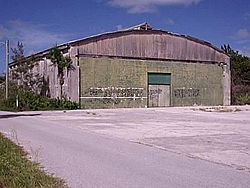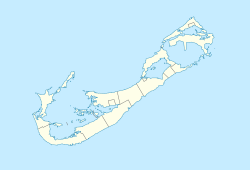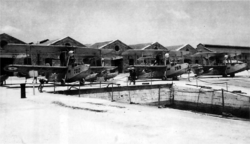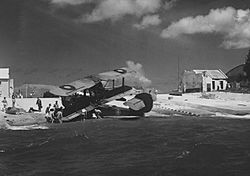Royal Naval Air Station Bermuda facts for kids
Quick facts for kids RNAS Bermuda or Boaz Island (HMS Malabar)
|
|
|---|---|

The surviving hangar at the Fleet Air Arm's Royal Naval Air Station on Boaz Island
|
|
|
Shown within Bermuda
|
|
| Coordinates | 32°19′16″N 064°50′25″W / 32.32111°N 64.84028°W |
| Type | Royal Naval Air Station |
| Site information | |
| Owner | Admiralty |
| Operator | Royal Navy |
| Site history | |
| Built | 1940 |
| In use | 1940-1946 |
| Garrison information | |
| Garrison | America and West Indies Station |
RNAS Bermuda was a special base for the Royal Navy's aircraft in Bermuda. RNAS stands for Royal Naval Air Station. It was first located at the Royal Naval Dockyard on Ireland Island. Later, it moved to Boaz Island and Watford Island.
The people working at RNAS Bermuda were part of the larger Royal Navy base in Bermuda, known as HMS Malabar. Bermuda became a very important base for the Royal Navy in the North-West Atlantic after the United States became independent. It had a large dockyard, a special house for the Admiral, and was home to a naval squadron.
Contents
History of the Air Station
In the 1900s, airplanes became a key part of naval warfare. Large warships started carrying seaplanes and flying boats. These planes were used for scouting, helping ships aim their guns, and sometimes for attacking enemies.
Ships usually launched these planes using special catapults. After landing on the water, the planes were lifted back onto the ship with a crane. Unlike aircraft carriers, these warships could not easily fix or protect their planes from bad weather.
The Fleet Air Arm
Between World War I and World War II, the Royal Air Force (RAF) was in charge of operating the Royal Navy's air branch, called the Fleet Air Arm (FAA).
From 1933, a small RAF team worked at the Dockyard on Ireland Island. Their job was to maintain the planes carried by Royal Navy cruisers based in Bermuda. These planes belonged to the Fleet Air Arm's No. 443 Flight. This team also stored new planes in crates. If a plane could not be fixed, a new one was put together.
Moving to Boaz Island
In 1936, the Navy decided to build a dedicated air station outside the main dockyard. They chose Boaz Island, which was not being used much. The island was covered with paved areas, two hangars (large buildings for planes), workshops, and living quarters.
Since only seaplanes and flying boats were used, no runway was needed. These planes were brought ashore using two slips. In July 1936, a new unit, 718 (Catapult) Flight, was formed. It used Fairey 111 and Osprey aircraft.
The new Royal Naval Air Station was finished in 1939, just as World War II began. It was named HMS Malabar II. The Royal Navy decided to take back control of its own air branch. Even though some RAF staff still helped, Boaz Island became a fully naval facility. Its main job was to maintain and store naval aircraft.
The change happened on May 24, 1939. 718 Flight became 718 Squadron, using Supermarine Walrus amphibians and Fairey Seafox seaplanes. These planes supported the six ships of the 8th Cruiser Squadron.
On January 21, 1940, all catapult units worldwide were combined into 700 Squadron. Soon after, Malabar II was closed as a separate base. It became part of the main HMS MALABAR base.
During the war, the waters around Bermuda were used for training. US Navy, Royal Canadian Navy, and British ships practiced here before joining the Battle of the Atlantic. The Fleet Air Arm used target-towing planes from Boaz Island to help train anti-aircraft gunners.
773 Fleet Requirements Unit was formed in Bermuda on June 3, 1940. It used Blackburn Roc aircraft, which were normally carrier planes. For use at RNAS Bermuda, they were fitted with floats to land on water. They towed targets for gunnery practice by Allied ships and a US Navy training center ashore.
When the US Army's Kindley Field opened in 1943, the floats were removed from the Rocs. They then operated from Kindley Field as landplanes. 773 Fleet Requirements Unit was disbanded on April 25, 1944.
RAF Flying Boat Station
Even though the Royal Navy took over RNAS Bermuda in 1939, the RAF still used the civil flying boat station at Darrell's Island. This was for their own flying boats from Transport Command and Ferry Command during the war. The pre-war airline, Imperial Airways/BOAC, also helped with war efforts.
The Bermuda Flying School was also created at Darrell's Island in 1940. It trained pilots for the RAF. The US Navy also started its air operations from Darrell's Island. They used Vought Kingfishers until their own base, USNOB Bermuda, was ready.
Air Patrols During Wartime
In the early years of the war, no unit in Bermuda was specifically tasked with flying air patrols. But air cover became very important. Bermuda was a key place for ships to gather before crossing the Atlantic in convoys. Air patrols were vital to fight against German U-boats (submarines).
The FAA station at Boaz Island began its own air patrols. They used planes and weapons they had on hand. Pilots from naval ships in port, and RAF and Bermuda Flying School pilots from Darrell's Island, helped fly these patrols.
Once the USA joined the war, the US Navy started flying anti-submarine patrols. They flew first from RAF Darrell's Island, then from their own base, USNOB Bermuda. The FAA station then stopped its own air patrols. Its normal operations also stopped in 1944. By this time, catapult aircraft were mostly no longer used.
Closure of the Base
The air station never reopened after the war. Boaz and Watford Islands were sold by the Admiralty in 1957. This happened after the Dockyard was reduced to a smaller base in 1951. As of 2020, the slipways and the northern hangar still exist.




